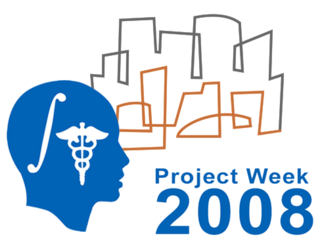Difference between revisions of "2008 Summer Project Week:DWI-DTI PrepTools"
From NAMIC Wiki
| Line 22: | Line 22: | ||
Details of the tool functionality were discussed thus far between UNC and Utah. The discussions have been summarized in [[2008_Core_1_UNC_Utah_DTI|it's event page]]: | Details of the tool functionality were discussed thus far between UNC and Utah. The discussions have been summarized in [[2008_Core_1_UNC_Utah_DTI|it's event page]]: | ||
| − | * | + | * "protocol" based execution via parameter files. |
| − | * | + | ** Parameter files contain all the settings/preferences/options |
| − | * | + | * Handles the conversion of DICOM data to volumetric image formats (NRRD) |
| − | ** Motion correction | + | * Automated quality control, corrects/rejects data, and provides a reporting facility. |
| − | ** Eddy current correction | + | ** Motion correction |
| − | ** Interpolation of | + | ** Eddy current correction |
| + | ** Interpolation of data | ||
** Quality Control | ** Quality Control | ||
| − | *** Rejection of interslice brightness | + | *** Rejection of interslice brightness |
| − | *** Local plausibility check with reconstructed DTI | + | *** Local plausibility check with reconstructed DTI |
*** FA/MD histogram comparison with atlas | *** FA/MD histogram comparison with atlas | ||
| − | *** Local dot product of principal direction with atlas | + | *** Local dot product of principal direction with atlas |
| − | *** Full brain tracking | + | *** Full brain tracking for possible flips, permutations of direction axes |
| − | *** Focus QC on white matter only | + | *** Focus QC on white matter only |
| − | * | + | * DTI data is generated, as well as FA/MD etc |
| − | |||
| Line 59: | Line 59: | ||
</div> | </div> | ||
| − | |||
===References=== | ===References=== | ||
Revision as of 18:37, 16 June 2008
Home < 2008 Summer Project Week:DWI-DTI PrepTools Return to Project Week Main Page |
Key Investigators
- UNC: Heather Cody Hazlett, Martin Styner, Zhexing Liu
- Utah: Casey Goodlett, Guido Gerig, Tom Fletcher
Objective
We are developing a tool for preparing diffusion weighted and diffusion tensor image data.
Details of the tool functionality were discussed thus far between UNC and Utah. The discussions have been summarized in it's event page:
- "protocol" based execution via parameter files.
- Parameter files contain all the settings/preferences/options
- Handles the conversion of DICOM data to volumetric image formats (NRRD)
- Automated quality control, corrects/rejects data, and provides a reporting facility.
- Motion correction
- Eddy current correction
- Interpolation of data
- Quality Control
- Rejection of interslice brightness
- Local plausibility check with reconstructed DTI
- FA/MD histogram comparison with atlas
- Local dot product of principal direction with atlas
- Full brain tracking for possible flips, permutations of direction axes
- Focus QC on white matter only
- DTI data is generated, as well as FA/MD etc
Approach, Plan
The tool will allow a "protocol" based execution via parameter files. The parameter files contain all the settings/preferences/options and this file can be created using the tool's GUI. This tool will handle the conversion of DICOM data to volumetric image formats (NRRD), perform automated quality control, correct data if possible, possibly reject parts of the data and provide a reporting facility.
Progress